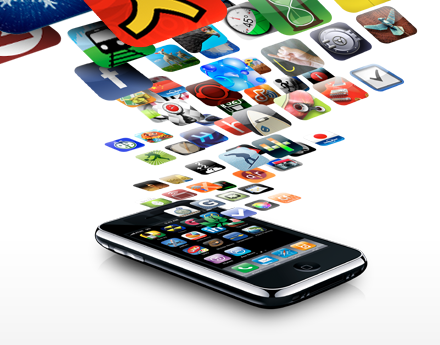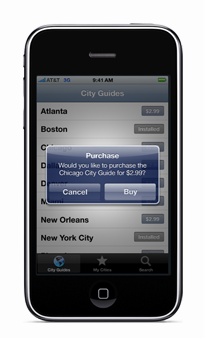 I don’t think it’s a stretch to say that Apple’s App Store has been more successful than even Apple ever imagined. It entered a market that had been completely controlled by carriers and handed the keys over to third-party developers to make their own apps. Just over nine months later, over 35,000 of those apps had been made which have been downloaded over a billion times. So it’s surprising when you see numbers like the ones Lightspeed Venture Partners published yesterday, estimating that Apple had made only somewhere between $20 and $45 million dollars in revenue off of the App Store. Surprising, until you dig deeper.
I don’t think it’s a stretch to say that Apple’s App Store has been more successful than even Apple ever imagined. It entered a market that had been completely controlled by carriers and handed the keys over to third-party developers to make their own apps. Just over nine months later, over 35,000 of those apps had been made which have been downloaded over a billion times. So it’s surprising when you see numbers like the ones Lightspeed Venture Partners published yesterday, estimating that Apple had made only somewhere between $20 and $45 million dollars in revenue off of the App Store. Surprising, until you dig deeper.
First, I’m not convinced these numbers are sound. While the author, Jeremy Liew, makes some good calculations, the numbers are still drawn largely from a survey. He did this because Apple doesn’t release actual numbers for App Store sales beyond the big numbers like a billion downloads. But Apple has given out what are probably better numbers than the survey results numbers over the past year. For example, back in August, none other than Steve Jobs himself said the App Store was pulling in $1 million a day in sales. Now, that was a long time ago, and the App Store has grown tremendously since then, but let’s go with that figure for argument’s sake.
$1 million a day means that Apple would be making $300,000 a day (its 30% cut). Extrapolated out over 10 months (the approximate age of the App Store), that would be about $90 million. That’s already double Liew’s high-end estimate. And Jobs would not throw a number like this out there lightly. Apple, if anything, likes to set expectations low and exceed them. For Jobs to throw out that figure and say that the App Store could one day be a billion dollar a year industry, to me means that he thinks it will at least be that big of a business.
Yes, it seems likely that the average price of apps have fallen since August given the rise of $0.99 apps, and probably that the ratio of free-to-paid apps has grown, but that’s why the daily sales angle is an interesting one to look at. No matter what ratios changed, there are also a ton more apps being downloaded — both paid and free — than there were in the first 30 days. And so if anything, this $1 million a day sales mark is probably low compared to what it’s at now.
 And there are other numbers that suggest this as well. Back in March, one analyst cut into Apple’s December quarter numbers and came out with $200 million in app sales just for that quarter. That’s probably way too high for a number of reasons — namely that it’s hard to know the ratio of iTunes/App Store/iPod accessory sales, which are all clumped together. But even if it’s way off, that’s just for the quarter, and it’s another sign that Liew’s numbers are probably way too low.
And there are other numbers that suggest this as well. Back in March, one analyst cut into Apple’s December quarter numbers and came out with $200 million in app sales just for that quarter. That’s probably way too high for a number of reasons — namely that it’s hard to know the ratio of iTunes/App Store/iPod accessory sales, which are all clumped together. But even if it’s way off, that’s just for the quarter, and it’s another sign that Liew’s numbers are probably way too low.
But even at $100 million, the App Store would still be a small drop in Apple’s bucket when it comes to revenue. But what Liew only indirectly hints at in his report is that this is what Apple has always been expecting. Since day one of its unveiling, Apple has said that it did not plan to make a lot of money off of the App Store. Sure, that may have been slightly disingenuous (again, Apple likes to set expectations low), but Apple’s stated rationale behind taking a 30% cut was to be able to keep the App Store up and running — not to make money.
Apple is a company notoriously mindful of its high margins, so why doesn’t it care about making a lot of money with the App Store? Dan Frommer of Silicon Alley Insider has this exactly right: it’s because the App Store is one of the, if not the, key driver of two products that are very high margin: The iPhone and the iPod touch. The App Store is based around the exact same model as its parent iTunes Store, which sells music at a very small markup in order to sell iPods. I don’t think I have to explain how well that has worked.
Another thing to think about is even with the success of the iPhone, Apple still has a very small percentage of the mobile market. Depending on the moves it makes over the next couple of years — namely getting into China and getting off of its exclusive AT&T deal in the U.S. — this percentage could grow by leaps and bounds. When that happens, App Store sales will continue to grow and thus, revenue from the App Store will continue to grow. Remember, the App Store is still not even a year old, and for much of that time, the number of iPhones and iPod touches in the market was nowhere near what it is today. The download pace is quickening, and the revenue pace should be as well.
Yet another variable is that Apple takes $99 a year from developers who develop for the App Store. There are tens of thousands of those. Again, not a huge chunk of money, but it all adds up.
But the biggest thing that these numbers draw attention away from is the true potential of the App Store. The reason for that is, it’s not here yet. When in-app payments launch with the iPhone 3.0 software this summer, the sky could literally be the limit in terms of how much both developers and Apple could make off of this. Yes, Apple will still take a 30% cut of these sales. And given that it has to do basically nothing more than it’s already doing to get that extra 30% — it’s pure gravy.
I think Liew’s numbers are well below the actual revenue numbers, but no matter if its $50 million, $100 million or $200 million, that’s not a huge amount of money for a company that has nearly $30 billion in cash in the bank. But going forward, that number is only going to increase both as the platform expands and as in-app purchases come into play. That’s not bad for a company that just wanted to make enough money to keep the App Store running.